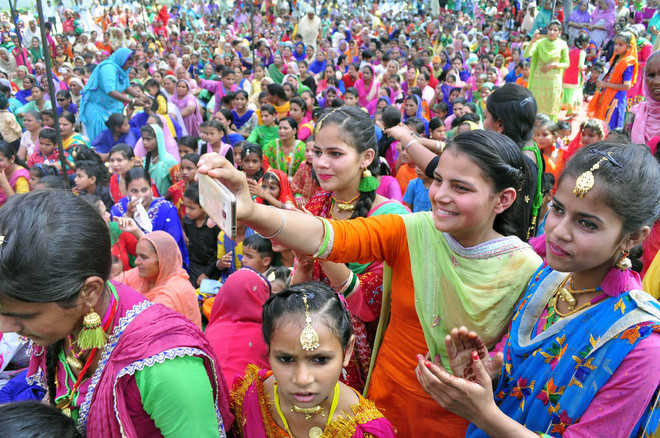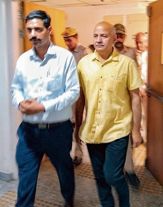
Preparation starts a month in advance. Girls from villages put in hours of practice for a fun-filled cultural programme. Tribune photos: Rajesh Sachar
Sanjam Preet Singh
Paramjeet Kaur stood in thoughtful silence, holding an invitation card from her native village. It conjured up memories of her mother’s bedtime stories, of the streets she once roamed and of friends with whom she had lost contact.
Tears welled up in her eyes. She had not visited her village Benara, in Sangrur district since 2002 — a land dispute with her brothers drove a wedge between them. But fate ordained her to take a step towards her village again after a gap of 13 years — the invitation came her way in February last year. And the occasion was Mela Dhiyaan Da (festival of daughters).
“After my mother passed away, there was nothing left for me in Benara. Mela Dhiyaan Da presented me with an opportunity to visit my village again,” said Paramjeet (60), back at the second such fair in Benara on March 27 this year.
Based on the concept of saanjh (association), Mela Dhiyaan Da is the time to meet old friends, and share common joys and griefs. Paramjeet met her friends after more than 20 years this time.
“This all-woman initiative is first-of-its-kind in Punjab with minimal intervention from men. Be it chalking out a plan for the event, raising funds or distributing invitation cards, girls are at the forefront,” said Charanjeet Kaur, one of the members of Awaaz-e-Jag Janani, which organises the fair.
It started from Patiala’s Lobana village on February 2, 2014. Since then, 14 fairs have been organised; all in Patiala and Sangrur districts. The last one was held in Lobana on April 3.
The preparation starts a month in advance. Girls put in hours of practice for a cultural programme that encompasses gidda, songs, poetry recitation and skits.
And on the D-day, there is never a dull moment. The atmosphere is marriage-like. The fair starts with a ribbon-cutting ceremony, wherein married daughters of a village are welcomed.
“Women are the VIPs at the fair. It is a space created by women for women,” said Navdeep Kaur, another member of the organising team, from Jakhepal village.
Was it easy? “There was opposition when we started out. Panchayat members said we were wasting our and others’ time. For them, it was simply a song and dance programme. They mocked us...” Charanjeet said, as her voice choked.
She paused, regained her composure and continued. “Not much has changed after two years. Elders of the village object to girls going door to door, raising funds for the fair. They stop others from giving us money.”
At the Benara fair, Charanjeet resolved to organise a successful fair in her village Lobana in spite of the challenges. “I am ready to fight it out.”
And on April 3, about 1,000 women attended the fair, organised by girls of Lobana and Kadionpur. Members of panchayats, who did not support the initiative, were present, but they took a backseat.
“Panchayat members have no interest because they are not the chief guests, nor are they honoured at the fair. They are unable to come to terms with girls organising the fair without their support,” said Karnail Singh, father of Navdeep.
Charanjeet knows the fight is at multiple levels. And it starts from home. “In villages, the freedom of girls is restricted to going to school. They are directed to return home early. There is no such restriction on boys,” said Amandeep Kaur of Awaaz-e-Jag Janani.
Another area of concern is the idiom in which girls are talked about. A case in point is a song that plays out on a Punjabi channel every morning: “Dhiyaan da satkar karo, mundeyaan wangu pyar karo.”
“The first and foremost is to acknowledge that this idiom is problematic. The patriarchal nature of our society is inherent in our language. Girls are considered bapu di pagri. An alternative idiom will evolve from our values after we address the gender question in our language,” said documentary filmmaker Daljit Ami.
Gurbaksh Singh Preetlari, the doyen of Punjabi literature, once wrote: “If one is to judge a country’s political or moral situation, ask a question on the condition of women in that country.”
As for Punjab, numbers speak for themselves. With a sex ratio of 895 women against 1,000 men (Census 2011), Punjab is ranked 27th among 35 states and union territories in the country. Besides, cases of female foeticide are common.
Remember Patran? Female foetuses were found in a pit in 2006.
So, where does Mela Dhiyaan Da fit in? Does it hits at patriarchy?
Rajesh Gill, professor of sociology, Panjab University, offers insight. “Does it change gender relations? What happens after the mela is over? Status quo is maintained,” she said.
Question members of Awaaz-e-Jag Janani on this and they say the mela is a small step towards empowerment. The bigger fight is still to be fought.
14 fairs and counting
Mela Dhiyaan Da started from Patiala’s Lobana village on February 2, 2014. Since then, 14 fairs have been organised; three in Lobana village, two each in Thuhi, Jakhepal and Benara, and one each in Kadionpur, Ajnoda, Sadhoheri, Dhanetha and Natt. All of these are in Patiala and Sangrur districts.
- Awaaz-e-Jag Janani, an all-girl initiative, organises the fairs; some of its members are Charanjeet Kaur (Lobana), Navdeep Kaur (Jakhepal), Mandeep Kaur (Benara), Shamim Akhtar (Thuhi) and Parneet Kaur (Ajnoda).
- On the money front, it costs between Rs 50,000 and Rs 1 lakh on one mela, depending on the population of a village. The main expenses are on langar, tent and speakers.
- In some villages, gurdwara committees help in preparing langar and arranging tent.
- At the Jakhepal fair held on November 16, 2014, about Rs 1.2 lakh was spent; about 11, 000 people participated.
- The International Democratic Platform and Scientific Awareness Social Welfare Forum honoured members of the organising team at a function in Sangrur on April 24.



























